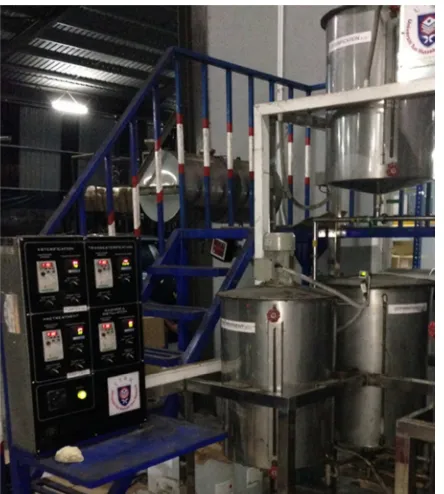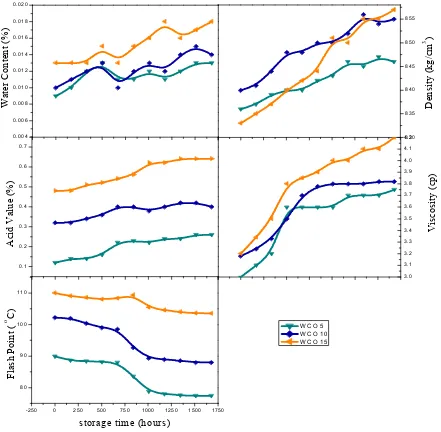The Effects Of Storage Duration On Biodiesel Derived From Waste
Cooking Oil
Norazwan Azman
1, a *, Mirnah Suardi
1,b, Amir Khalid
1, c 1Automotive Research Group (ARG), Centre for Energy and Industrial Environment Studies (CEIES), UniversitiTun Hussein Onn Malaysia, Parit Raja, BatuPahat, 86400 Johor, Malaysia.
a
azwanazman1989@gmail.com, camirk@uthm.edu.my
Keywords: Waste cooking oil (WCO), acid value, viscosity, flash point, density, and water content.
Abstract
The use of fossil fuels as energy sources has grown to significantly be likely to have a major environmental impact. Reduction of world oil reserves and increasing environmental concerns have prompted alternative is found and renewable source of energy called biodiesel. Biodiesel fuel from vegetable oil is considered as the best candidates for diesel fuel replacement in diesel engines because of its closer. Fuel prices are going up day by day in the world. Thus, the means and methods have been trying for years to get fuel alternative outcomes. This study investigated the effects of different storage periods used in quality biodiesel blends (B5, B10, B15) of waste cooking oil and diesel fuel under low temperature and the temperature of the environment. Biodiesel samples were stored in glass containers under indoor conditions, and outdoor conditions for 10 weeks in total. These samples were monitored on a weekly basis through the test properties. The experimental density, viscosity, acid value, water content and flash point were discussed in detail. Biodiesel storage at low temperatures is suitable and more advantageous because the impact on the physical properties is minimal and beneficial to slow down the degradation of biodiesel and storage.
Introduction
This study is about the effects of storage duration on biodiesel derived from waste cooking oil. Caused by the reduction of the world's petroleum reserves and improvement environmental concerns, there is a great demand for alternative sources of petroleum-based fuels, including diesel and gasoline fuels [1]. Biodiesel is a clean renewable fuel, has recently has been regarded as the best candidate to substituting diesel fuel because it may utilize in any compression ignition engine without requiring modification [2]. Biodiesel refers to an alternative fuel for diesel engines that are now becoming increasingly popular due to the reform, lower emissions, higher rates of biodegradability and less toxic level. This in turn contributes to sustainability and reduction of emission of greenhouse gases and environmental degradation [2-3]. Chemically, biodiesel is a blend of methyl esters of long chain fatty acids and are typically made of the non-toxic, biological sources like vegetable oils, animal fats, or even used cooking oil (UFO) [4]. Examples of vegetable oil which can be used to make biodiesel are palm oil, soybean oil, sunflower oil, peanut oil, corn oil, olive oil, jatropha and coconut oil [5].
To produce a biodiesel transesterification process should be done where the glycerine is separated from vegetable oil and leave the two products methyl esters (the chemical name for biodiesel) and glycerine (a valuable product is commonly used in the manufacture of soap). This study is the tendency of degraded biodiesel from waste cooking oil, so I will test the waste cooking oil by Fatty Acid Methyl Ester (FAME) content to make sure the waste cooking oil is biodiesel. The requirements and test method that will be used include density at 15°C, viscosity at 40°C, flash point, water content, and acid value [6-9].
Experimental Setup
While the Esterification process is a process to reduce free fatty acid (FFA) content in raw materials is converted into esters. Esterification process that must be done to the raw material that contains more than 2% FFA [10]. For the transesterification and esterification process does it at Lojipadu Biodiesel FKMP. The experimental apparatus for esterification and transesterification as shown in Figure1.
Blending process was required to ensure that the mixture of diesel and biodiesel is well mixed uniformly. Schematic diagram of blending process is shown in Figure 2. During blending process, the laboratory scale blending machine was operated at 60°C and the mixture was stirred at 70°C for 1 hour. The rotating blade speed was adjusted to maintain the same speed at 270 RPM.
The properties test considered to be investigated are included density, kinematic viscosity, water content, acid value and flash points test [11-12]. These properties test are based on the European Standard for Biodiesel (EN 14214) and American Society of Testing Materials (ASTM D6751). The density properties were measured by Metter Toledo Diamond Scale modelled JB703-C/AF. Kinematic viscosity of biodiesel can measure with an instrument is 700 viscolite. The water content and acid value in the biodiesel sample were measured by Volumetric KF Titrator model v20 and titration process. The term of acid value is expressed as the amount (mg) of potassium hydroxide required to neutralize one gram of the biodiesel. During acid value measurement, the sample is titrated with alcoholic KOH using phenolphthalein as indicator. The flash point measured by Pensky-Martens PMA 4.
Results and Discussion
Physical properties can be seen or measured without changing the composition of matter and explain it. In this study, it is important to investigate the physical properties of the sample WCO to make fuel for diesel engines. Among the properties that can be investigated is the acid value, viscosity, flash point, water content, and density. The effects of storage duration on biodiesel derived from waste cooking oil blending ratio on biodiesel properties was investigated at the base standard diesel fuel (STD Fuel) for biodiesel derived from waste cooking oil (WCO) of 5 (WCO5), 10 (WCO10) and 15 (WCO15) for variant storage temperature of room temperature and outdoor temperature. Figure 3 clearly demonstrate that the increasing the storage duration at room temperature promote more biodiesel acid value, viscosity, flash point, water content, and density
[image:2.595.64.286.143.390.2]Figure 1:Apparatus for esterification and transesterification
especially the higher biodiesel blending ratio WCO15. For all physical properties testing the increasing of blending ratio thus predominantly influences the increasing of storage duration except the flash point testing it shown decreasing of blending ratio it influences the decreasing of fuel flash point, at which time the storage duration at room temperature of biodiesel is expected to be strongly influenced by the purified waste cooking oil methyl ester.
Figure 3: Effect storage duration at room temperature
Figure 4 clearly indicate that the increasing the storage duration at outdoor temperature encourage more biodiesel acid value, viscosity, flash point, water content, and density especially the higher biodiesel blending ratio WCO15. For all physical properties testing the increasing of blending ratio thus predominantly influences the increasing of storage duration except the flash point testing it shown decreasing of blending ratio it influences the decreasing of fuel flash point, that at the time the storage duration at outdoor temperature of biodiesel is expected to be deeply affected by the purified waste cooking oil methyl ester.
830 835 840 845 850 855 0.004 0.006 0.008 0.010 0.012 0.014 0.016 0.018 0.020 0.1 0.2 0.3 0.4 0.5 0.6 0.7 3.0 3.1 3.2 3.3 3.4 3.5 3.6 3.7 3.8 3.9 4.0 4.1 4.2
-250 0 250 500 750 1000 1250 1500 1750 80 90 100 110 D en si ty ( k g /c m 3 )
W C O 5 W C O 10 W C O 15
W at er C o n te n t (% ) A ci d V al u e (% ) V is co si ty ( cp ) F la sh P o in t ( o C )
Figure 4: Effect storage duration at outdoor temperature
Conclusion
In this research, the WCO biodiesel with different blending ratio (B5, B10, and B15) which storage at indoor condition and outdoor condition.The summary as follows:
1. This study shows that low changes in the physical properties of biodiesel mixed samples when stored at ambient temperature or low temperature.
2. Indoor storage conditions which are less susceptible to delayed break light chain fatty acids. 3. Biodiesel storage at low temperatures is suitable and more advantageous because the impact
on the physical properties is minimal and beneficial to slow down the degradation of biodiesel and storage.
830 835 840 845 850 855 860 865 870 0.005 0.010 0.015 0.020 0.025 0.030 0.035 0.040 0.1 0.2 0.3 0.4 0.5 0.6 0.7 3.0 3.1 3.2 3.3 3.4 3.5 3.6 3.7 3.8 3.9 4.0 4.1 4.2
0 250 500 750 1000 1250 1500 1750
70 80 90 100 110 120 D en si ty ( k g /c m 3 ) W at er C o n te n t (% ) WCO 5 WCO 10 WCO 15 A ci d V al u e (% ) V is co si ty ( cp ) F la sh P o in t ( o C )
Acknowledgement
The authors also would like to thank the Ministry of Higher Education Malaysia for supporting this research under Exploratory Research Grant Scheme (ERGS) vot. E032.
References
[1] Lin, C., Lin, H., & Hung, L. (2006). Fuel Structure And Properties Of Biodiesel Produced By The Peroxidation Process. Fuel, 85(12-13), 1743–1749. Doi:10.1016/J.Fuel.2006.03.010 [2] Board, N. B. (2008). Biodiesel , Renewable Diesel & Co-Processed Renewable Diesel, (D),
2008–2009.
[3] Board, N. B. (2010). Environmental Benefits.
[4] Leung, D. Y. C., Wu, X., & Leung, M. K. H. (2010). A Review On Biodiesel Production Using CatalyzedTransesterification. Applied Energy, 87 (4), 1083–1095. Doi:10.1016/J.Apenergy.2009.10.006
[5] Sharma, Y. C., Singh, B., &Upadhyay, S. N. (2008). Advancements In Development And Characterization Of Biodiesel: A Review. Fuel, 87(12), 2355–2373.
[6] SehmusAltun, FevziYasarAndCengizOner (2010). The Fuel Properties Ofmethyl Esters Produced From Canola Oil- Animal Tallow Blends By Base-CatalyzedTransesterification. International Journal Of Engineering Research And Development, 4.
[7] Knothe G. (2007). Some Aspects Of Biodiesel Oxidative Stability, Fuel Process Tchnol, 88, 669-77.
[8] Demirbas, A. (2009). Progress And Recent Trends In Biodiesel Fuels. Energy Conversion And Management, 50 (1), 14–34. Doi:10.1016/J.Enconman.2008.09.001
[9] Amir Khalid, N.Tamaldin, M. Jaat, M. F. M. Ali, B. Manshoor, Izzuddin Zaman, Impacts of Biodiesel Storage Duration on Fuel Properties and Emissions”, Procedia Engineering 68(2013) 225 – 230, Elsevier, 2013.
[10] Meher, L. C., VidyaSagar, D., &Naik, S. N. (2006). Technical Aspects Of Biodiesel Production By Transesterification—A Review. Renewable And Sustainable Energy Reviews, 10 (3), 248–268. Do: Http: //Dx. Doi. Org/10.1016/J.Rser.2004.09.002
[11] Amir Khalid, “ Effect of Ambient Temperature and Oxygen Concentration on Ignition and Combustion Process of Diesel Spray”. Asian Journal of Scientific Research 6(3),pp.434-444, 2013.


